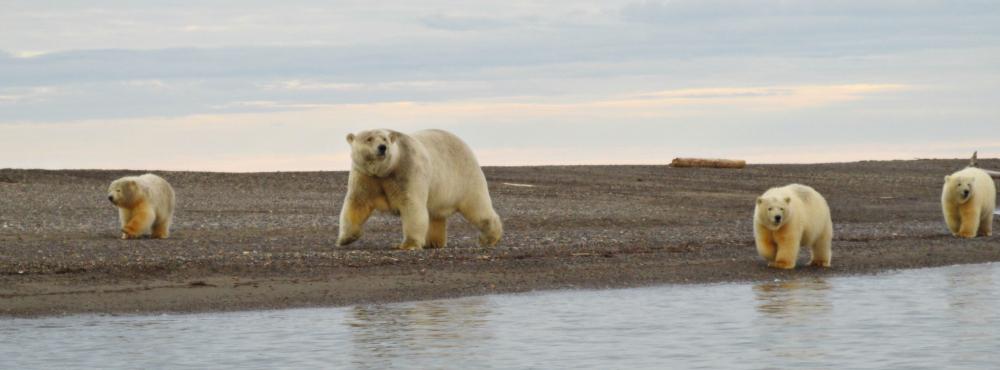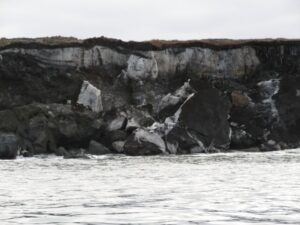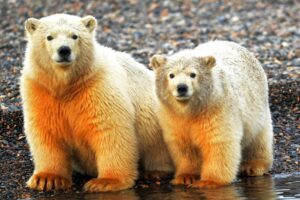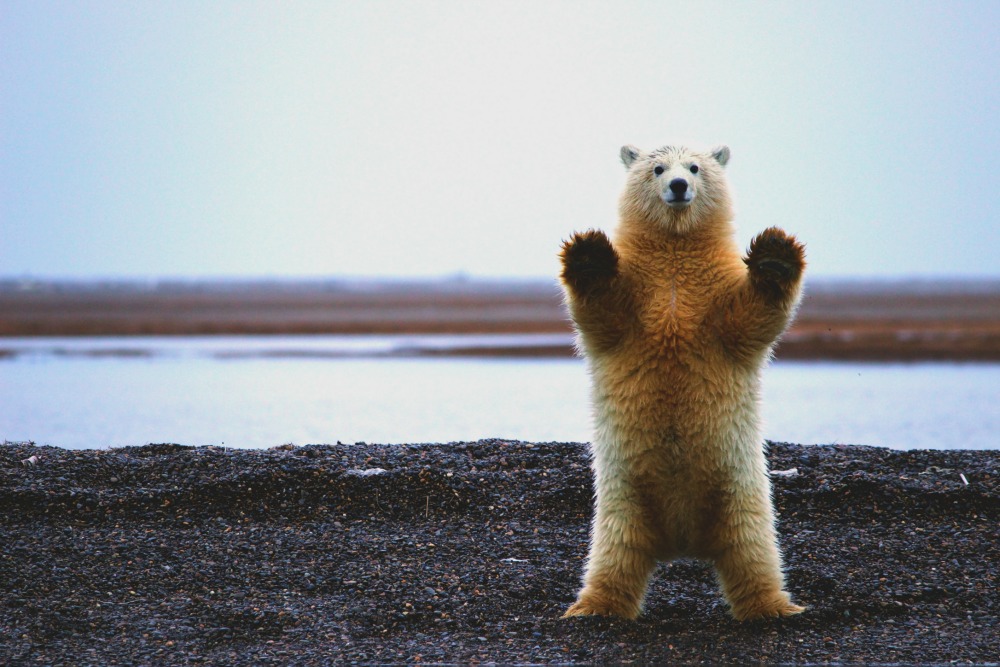
Trustees’ Polar Bear Trip Was an Enlightening Adventure
In September 2016, a group of Trustees for Alaska supporters, Board and staff flew to the edge of the Arctic Ocean to observe polar bears. Executive Director Vicki Clark shares her story of the trip:
As we flew into the small Barter Island airport, it was easy to see why this place has become a destination for viewing polar bears. The village of Kaktovik is located on Barter Island and within the Arctic National Wildlife Refuge. On the north part of the island, there are a series of sand and gravel spits that create barriers for Kaktovik and Jago Lagoons. These protected waters are calmer than the Arctic Ocean on the other side. Tour guides in small boats take people out to the spits to watch the bears without worry of dangerous direct encounters with these apex predators.
In mid-September 2016, I had this wonderful experience with nine Trustees for Alaska donors and board members. It was an amazing experience! I’ve read about polar bears and their plight, but seeing it first-hand was marvelous and sobering.
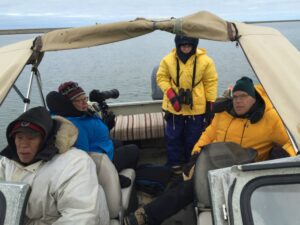
Bundled up in the boat heading out to watch polar bears with our guide Jack Kayotuk. Photo by Vicki Clark.
After getting settled in at the Waldo Arms Hotel, we put on our many layers and went out on the lagoons with Akook Arctic Adventures, owned by Jack Kayotuk. Jack has lived, hunted, and fished in these Arctic lands and waters all of his life. His partner is Steve Kazlowski, a professional photographer who has photographed polar bears in Alaska for over 15 years. He wrote a great book titled, The Last Polar Bear: Facing the Truth of a Warming World. Together, Jack and Steve have been sharing polar bears with the public for ten years.
Our Polar Bear Adventure Begins!
We learned from Steve that the weather was forecast to be very high winds on Sunday. To ensure that our group would get as much time with the bears as possible, we would go out in three 4-5 hour blocks Friday and Saturday. We began our adventure with a five-hour trip on Thursday.
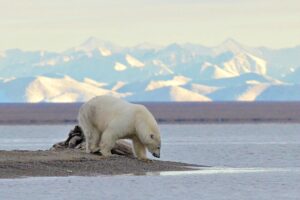
Polar Bear at the end of the spit. In the background you can see the Coastal Plain and the Brooks Range in the Arctic National Wildlife Range. Photo courtesy of Sheri Spitzer.
Our first stop was the local whale bone pile. The village of Kaktovik has been putting the butchered remains of the three bowhead whales they are allowed to take each year at the end of the spit beyond the airport. The three whales taken in August were small and the bones had already been picked clean. As villagers continue to process their take of the whales as well as other subsistence foods, they continually add remains at this site. I didn’t realize how close the area is to the village until I was there. I was glad we were in a boat and not on foot!
At the bone pile, we got our first experience seeing several bears. I’ve seen brown bears and black bears before at close distances. Nothing compares to the presence of the polar bear.
From the bone pile, we went out to the spits and found many bears sleeping or moseying along. The spits have a lot of driftwood, which comes from the MacKenzie River just across the border in Canada. The big logs provide places for the bears to snuggle in as well as to use as toys in the water.
A Buried Basal Glacier
We talked about the local landscape. Some of us had read an article on the wall at the hotel about a massive ice structure nearby that was determined by scientists to be buried basal glacier ice associated with a Late Pleistocene glaciation. Jack said that he knew where it was, but we would have to go outside the barrier islands to reach it. Since it was a calm day, we decided to go for it. Even on a calm day, outside the spits, we hit rough seas and our little boat hit some bone-jarring waves. We reached the site and it was odd to see the ice breaking off from what appeared to be tundra. Definitely not an everyday sight!
Climate Change and Polar Bears
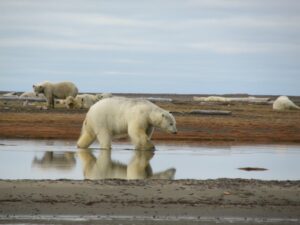
The polar bears hang out in the area waiting for new bones to be added bone pile or the ice to come back in. Photo by Vicki Clark.
Those first days of our trip, we were very lucky to have calm and warming weather. That gave us some great time to really observe the bears. We learned a lot from talking with Steve and Jack as well as U.S. Fish and Wildlife Service employees. The counts this year had found 50-60 bears in the area. With climate change and the declining sea ice in the Arctic, these polar bears have seen big changes in their ability to get food.
While the sea ice is over the shallow continental shelf (less than 60 m), it is easy for polar bears to hunt for their preferred prey, ringed and bearded seals. The continental shelf in the Beaufort Sea extends out approximately 100 km (62 miles) offshore. In summer, sea ice is now receding over 500 km offshore. The Beaufort Sea subpopulation bears, found around Kaktovik, must make the choice to stay on the ice as it recedes, stay onshore, or swim to the ice. Whatever the choice, once the ice recedes beyond the continental shelf, food is scarce or non-existent. Then, the bears must wait for the sea ice to come back to shore, usually in October. In contrast, the polar bears in the Chukchi Sea have an extensive continental shelf extending approximately 800 km.
Forced Together
I had always heard that polar bears were solitary creatures, but at Kaktovik they are forced into close quarters. I saw the bears being leery of each other, but once they seem to recognize each other, especially young male bears, they will travel and play together. Sows with cubs are, of course, much more defensive and often chase off other bears.
A big treat for our group, and many others this year, was a sow with three cubs of the year. The cubs were very playful and often seemed to be trying the patience of the sow. We spent hours with this family. Our first evening, the three cubs entered the water and played with a stick and each other for over an hour. During that time, other bears entered the water in the area and 7 or 8 bears played in groups of two or three. Our entire group could not go out at the same time, and the last group got another show when one of the cubs stood on its hind legs and seemed to be waving! What a delight!
What’s the polar bear’s future?
Polar bears are in peril due to climate change. Their habitat is literally melting from right underneath them. The bears evolved 350,000 to 6 million years ago and need the sea habitat that the extreme cold provides. It is unclear whether there are adaptations that can occur in time to save them. It’s a complex issue, but one that I hope can be resolved. We must do what we can to mitigate the polar bears’ plight, so these magnificent animals can survive. I feel very lucky to have been able to spend time with polar bears. This experience will stay with me for the rest of my life.

A playful cub stood up on its hind end and seemed to be waving goodbye to us! Photo courtesy of Sheri Spitzer.
Trustees for Alaska will continue to work to protect and defend Alaska’s lands, waters, wildlife, and people, including the habitat of the polar bear.



